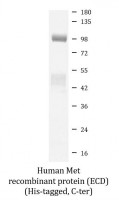ARG70307
Human Met recombinant protein (His-tagged, C-ter)
Human Met recombinant protein (His-tagged, C-ter) for Binding Activity,SDS-PAGE and Human
概述
| 产品描述 | HEK293 expressed, His-tagged (C-ter) Human Met recombinant protein. |
|---|---|
| 反应物种 | Hu |
| 应用 | Binding, SDS-PAGE |
| 靶点名称 | Met |
| 物种 | Human |
| A.A. 序列 | Glu25 - Thr932 of Human Met (NP_000236.2) with 6X His tag at the C - terminus. |
| 表达系统 | HEK293 |
| 別名 | Scatter factor receptor; c-Met; HGF receptor; HGFR; EC 2.7.10.1; SF receptor; AUTS9; Proto-oncogene c-Met; Tyrosine-protein kinase Met; HGF/SF receptor; Hepatocyte growth factor receptor; RCCP2; DFNB97 |
应用说明
| 应用说明 | Binding activity test: Measured by its binding ability in a functional ELISA. Immobilized recombinant human HGFR at 2 ug/ml (100 µl/well) can bind Rrecombinant human HGF with a linear range of 25-250 ng/ml. |
|---|
属性
| 形式 | Powder |
|---|---|
| 纯化说明 | 0.22 µm filter sterilized. Endotoxin level is <0.1 EU/µg of the protein, as determined by the LAL test. |
| 纯度 | > 95% (by SDS-PAGE) |
| 缓冲液 | PBS (pH 7.4) |
| 复溶 | Reconstitute to a concentration of 0.1 - 0.5 mg/ml in sterile distilled water. |
| 存放说明 | For long term, lyophilized protein should be stored at -20°C or -80°C. After reconstitution, aliquot and store at -20°C for up to one month, at 2-8°C for up to one week. Storage in frost free freezers is not recommended. Avoid repeated freeze/thaw cycles. Suggest spin the vial prior to opening. |
| 注意事项 | For laboratory research only, not for drug, diagnostic or other use. |
生物信息
| 基因名称 | MET |
|---|---|
| 全名 | MET proto-oncogene, receptor tyrosine kinase |
| 背景介绍 | This gene encodes a member of the receptor tyrosine kinase family of proteins and the product of the proto-oncogene MET. The encoded preproprotein is proteolytically processed to generate alpha and beta subunits that are linked via disulfide bonds to form the mature receptor. Further processing of the beta subunit results in the formation of the M10 peptide, which has been shown to reduce lung fibrosis. Binding of its ligand, hepatocyte growth factor, induces dimerization and activation of the receptor, which plays a role in cellular survival, embryogenesis, and cellular migration and invasion. Mutations in this gene are associated with papillary renal cell carcinoma, hepatocellular carcinoma, and various head and neck cancers. Amplification and overexpression of this gene are also associated with multiple human cancers. [provided by RefSeq, May 2016] |
| 生物功能 | Receptor tyrosine kinase that transduces signals from the extracellular matrix into the cytoplasm by binding to hepatocyte growth factor/HGF ligand. Regulates many physiological processes including proliferation, scattering, morphogenesis and survival. Ligand binding at the cell surface induces autophosphorylation of MET on its intracellular domain that provides docking sites for downstream signaling molecules. Following activation by ligand, interacts with the PI3-kinase subunit PIK3R1, PLCG1, SRC, GRB2, STAT3 or the adapter GAB1. Recruitment of these downstream effectors by MET leads to the activation of several signaling cascades including the RAS-ERK, PI3 kinase-AKT, or PLCgamma-PKC. The RAS-ERK activation is associated with the morphogenetic effects while PI3K/AKT coordinates prosurvival effects. During embryonic development, MET signaling plays a role in gastrulation, development and migration of muscles and neuronal precursors, angiogenesis and kidney formation. In adults, participates in wound healing as well as organ regeneration and tissue remodeling. Promotes also differentiation and proliferation of hematopoietic cells. May regulate cortical bone osteogenesis (By similarity). (Microbial infection) Acts as a receptor for Listeria monocytogenes internalin InlB, mediating entry of the pathogen into cells. [UniProt] |
| 细胞定位 | Membrane; Single-pass type I membrane protein. Isoform 3: Secreted. [UniProt] |
| 预测分子量 | 156 kDa |
| 翻译后修饰 | Autophosphorylated in response to ligand binding on Tyr-1234 and Tyr-1235 in the kinase domain leading to further phosphorylation of Tyr-1349 and Tyr-1356 in the C-terminal multifunctional docking site. Dephosphorylated by PTPRJ at Tyr-1349 and Tyr-1365. Dephosphorylated by PTPN1 and PTPN2. Ubiquitinated. Ubiquitination by CBL regulates MET endocytosis, resulting in decreasing plasma membrane receptor abundance, and in endosomal degradation and/or recycling of internalized receptors. [UniProt] |
检测图片 (1) Click the Picture to Zoom In






